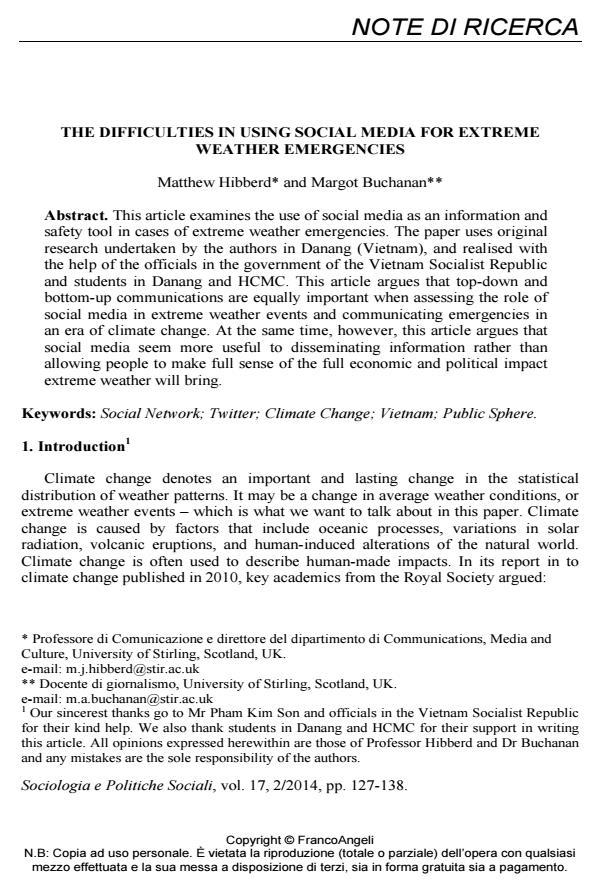The difficulties in using social media for extreme weather emergencies
Titolo Rivista SOCIOLOGIA E POLITICHE SOCIALI
Autori/Curatori Matthew Hibberd, Margot Buchanan
Anno di pubblicazione 2014 Fascicolo 2014/2 Lingua Italiano
Numero pagine 11 P. 127-137 Dimensione file 70 KB
DOI 10.3280/SP2014-002008
Il DOI è il codice a barre della proprietà intellettuale: per saperne di più
clicca qui
Qui sotto puoi vedere in anteprima la prima pagina di questo articolo.
Se questo articolo ti interessa, lo puoi acquistare (e scaricare in formato pdf) seguendo le facili indicazioni per acquistare il download credit. Acquista Download Credits per scaricare questo Articolo in formato PDF

FrancoAngeli è membro della Publishers International Linking Association, Inc (PILA)associazione indipendente e non profit per facilitare (attraverso i servizi tecnologici implementati da CrossRef.org) l’accesso degli studiosi ai contenuti digitali nelle pubblicazioni professionali e scientifiche
This article examines the use of social media as an information and safety tool in cases of extreme weather emergencies. The paper uses original research undertaken by the authors in Danang (Vietnam), and realised with the help of the officials in the government of the Vietnam Socialist Republic and students in Danang and HCMC. This article argues that top-down and bottom-up communications are equally important when assessing the role of social media in extreme weather events and communicating emergencies in an era of climate change. At the same time, however, this article argues that social media seem more useful to disseminating information rather than allowing people to make full sense of the full economic and political impact extreme weather will bring.;
Keywords:Social Network; Twitter; Climate Change; Vietnam; Public Sphere
- Baym, N. 2011 Personal Communications in the Digital Age, Cambridge, Polity Press.
- Boyd, D. and Ellison, N.B. 2007 Social Network Sites: Definition, History and Scholarship in «Journal of Computer Mediated Communication», 13, 1 http://jcmc.indiana.edu/vol13/issue1/boyd.ellison.html (accessed 31/7/2014)
- Brown, G. 2008 Speech to the UN General Assembly, October.
- Bruns A., Burgess, J., Crawford, K., and Shaw, F. 2012 #qldfloods and @QPSMedia: Crisis Communication on Twitter in the 2011 South East Queensland Floods, Brisbane, ARC Centre of Excellence for Creative Industries and Innovation.
- Castells, M. 2007 Communication, Power and Counter-power in the Network Society in «The International Journal of Communication», 1, pp. 238-266. 2009 Communication Power, Oxford, Oxford University Press.
- Fearn-Banks, K. 1996 Crisis Communications: A Casebook Approach. Mahwah, NJ, USA, Lawrence Erlbaum Associates, Inc.
- Redekop, B. (ed.) 2010 Leadership for Environmental Sustainability, New York, Routledge. Reuters
- 2013 Vietnam Government Continues Clampdown on Social Media. 28th November 2013.
- http://world.time.com/2013/11/28/vietnamese-communist-party-continuessocial-media-clamp-down/
- Royal Society 2010 Climate Change. A Summary of the Science, London, Royal Society.
- Solomon, S. 2012 Cascades in Cairo: The Role of Facebook and Twitter in the Egyptian Revolution of 2011 Thesis http://hdl.handle.net/10822/555728 (accessed 31/07/2014) University of Stirling (Various Authors) 2002 Corporate Communications Module.
- A Multi-Dimensional Analysis of El Niño on Twitter: Spatial, Social, Temporal, and Semantic Perspectives Ye, Wei, in ISPRS International Journal of Geo-Information /2019 pp.436
DOI: 10.3390/ijgi8100436
Matthew Hibberd, Margot Buchanan, The difficulties in using social media for extreme weather emergencies in "SOCIOLOGIA E POLITICHE SOCIALI" 2/2014, pp 127-137, DOI: 10.3280/SP2014-002008